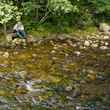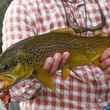For those that care about wild steelhead, the idea that hatchery-raised and wild steelhead don't mix has long been a matter of common sense. Wild steelhead are a marvel. Raised in our rivers and streams, they migrate to our oceans where they battle harsh conditions and staggering odds against survival. Those that do survive, and return to the rivers and streams where they were reared, pass on their uniquely adapted genetics to a new generation of wild steelhead. For many of us, it stands to reason that mixing in millions of hatchery steelhead — which are bred and raised in concrete tanks where pellet-feeding and crowded conditions are the order of the day — with our wild steelhead would inevitably lead to a degradation of our wild stocks. However, hatchery proponents have long argued that hatchery and wild steelhead do not differ significantly at the genetic level and that inter-breeding these two stocks presents no danger to the fitness of our wild steelhead.
A study published yesterday in Nature Communications offers evidence that not only do hatchery steelhead and wild steelhead differ genetically, but that these differences are major, can occur in a single generation and can be passed on to offspring. The study, which was performed by scientists Michael Blouin of Oregon State University and Mark Christie of Purdue University and was supported by the Bonneville Power Administration and the Oregon Department of Fish and Wildlife, was conducted on winter-run steelhead from the Hood River in Oregon.
Hatchery steelhead are considered to be a domesticated animal. Like other once-wild animals that have been transferred to artificial environments, the unique conditions of human-created environments lead to genetic adaptations, some of which can occur very rapidly. These modifications lead to populations that are more genetically suited to survival in their artificial environments than in the wild environment from which their species originated.
However, while the genetic effects of domestication are well documented, much remains unknown about the underlying genetic mechanisms by which domestication occurs. Blouin and Christie's study compared the offspring of wild (W) and hatchery (H) steelhead raised in a common environment in order to examine differences in genetic expression.
According to the study, "A series of crosses involving two first-generation hatchery fish (HxH), two wild fish (WxW), or one hatchery and one wild fish (HxW and WxH reciprocal crosses) were performed at the Parkdale hatchery. The offspring were reared in an identical environment at the hatchery until the swim-up fry stage" at which point the fish were collected and their genetic sequences examined.
Perhaps not surprisingly, the researchers found that the offspring of wild fish (WxW) and first-generation hatchery fish (HxH) differed in the activity of more than 700 genes.
The researchers noted that "differences in survival and reproductive success between hatchery and wild fish have long offered evidence of rapid adaptation to the hatchery environment. This new DNA evidence directly measured the activity of all genes in the offspring of hatchery and wild fish. It conclusively demonstrates that the genetic differences between hatchery and wild fish are large in scale and fully heritable."
According to Blouin, "A fish hatchery is a very artificial environment that causes strong natural selection pressures. A concrete box with 50,000 other fish all crowded together and fed pellet food is clearly a lot different than an open stream."
Mark Christie, the lead author of the study, noted that "We observed that a large number of genes were involved in pathways related to wound healing, immunity, and metabolism, and this is consistent with the idea that the earliest stages of domestication may involve adapting to highly crowded conditions."
The most likely explanation for the rapid, genetic changes may be a process known as epigenetic modification. In epigenetic modification, DNA sequences remain unaltered, but external influences cause modifications that turn genes "on" or "off". These modifications are the result of processes which occur "on top" of the DNA sequence, such as modifications to histones (proteins that "package" DNA and affect its readability) or DNA methylation (during which methyl groups that play important roles in gene repression are added to DNA). Both histone modification and DNA methylation have been shown to result in heritable modifications to DNA.
The authors went on to note, "the genetic changes are substantial and rapid ... It’s literally a process of evolution at work, but in this case it does not take multiple generations or long periods of time."































Comments
Fred Rickson replied on Permalink
It sounds like the study points to gene regulation, not genetic change. And, was the genotype of W and H characterized before the study in order to recognize 700 changes at the end?
SteveD replied on Permalink
Well, hate to state the obvious but it is phenotypic expression that drives functional expression. Totally different environments (hatchery vs wild) drive very different genomic expression. Even if the genomes appear to be virtually identical.
Vang replied on Permalink
Why wouldn't genetics work the other way around too? Couldn't hatchery fish eventually develop wild genetics? Why couldn't we just clean up our rivers and lakes, and allow the fish to what they naturally do. There's evidence that populations bounce back when given the chance. So do we stop feeding the wild with hatchery raised fish? Probably yes. Do we stop raising fish in farms? Probably yes. Ok, then how do we develop a sustainable fishery without collapsing the fishing industry? Perhaps, those that are in the business of catching and selling fish should also spend effort cleaning our rivers and waters where fish come to spawn? OR perhaps a tax should be levied on those who sell and buy fish, with the tax money going towards cleaning our rivers and waters where those fish spawn. Plus, it'll probably discourage harvesting of more fish and eating less of it. Thoughts?
Virgil Jones replied on Permalink
As to passing taxes that might have a significant impact on any environmental or conservation issue are a pipedream. For example, they are fighting tooth and nail to stop those idiots from allowing a Canadian mining company from building a probable disaster of a mine in Bristol Bay. Lots of fish and fish people there. By the way, those idiots are the same people who pass massive tax cuts. For the extremely wealthy.
Thought about that?
Pages